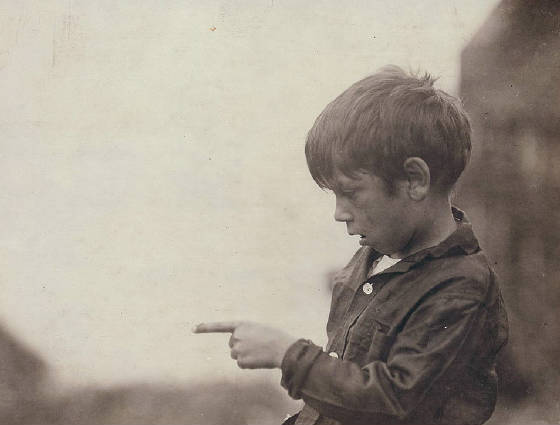
Lewis Hine caption: “I cut my finger nearly off, cutting sardines the other day.” Seven year old Byron. Location: Eastport, Maine, August 1911.
“He was extremely brilliant. If he had had money, he certainly would have gone to college. He liked to quote poetry and the classics.” –George Hamilton, nephew of Byron Hamilton
“He was always a nice boy, easy to get along with. He and his family moved away to Massachusetts when he finished high school, and then we used to see him a little bit in the summertime. His brothers and sisters never moved back, but his parents, William and Susan, moved back.” -Elaine Lodge, Byron’s first cousin
According to the 1910 census, there were six persons with the first name of Byron living in Eastport, Maine, among a population of about 5,000. Five of the six were born between 1901 and 1905, including Byron Hamilton. At least some members of almost every family in Eastport worked in the seafood industry, on lobster and fishing boats, and at the canneries, where boys and girls as young as five cut fish and packed cans of sardines. In 12 of the 53 Eastport photos, Hine mentions cut fingers in the caption.
At least one member of the Hamilton family appears in seven of the photos. There is a photo of Byron that is virtually identical to the one above, but in the caption, Byron says to Hine, “I cut my finger off,” instead of “I almost cut my finger off.” Obviously, he did not lose his finger.
According to the census, Social Security death records and family testimony, Byron Andrew Hamilton was born in Eastport on February 28, 1904, the youngest of four children of William James Hamilton and Susan (Farris) Hamilton, who married about 1893. As early as 1900, the Hamiltons owned their home at 22 Franklin Street, just south of the center of town. William worked in the cannery.
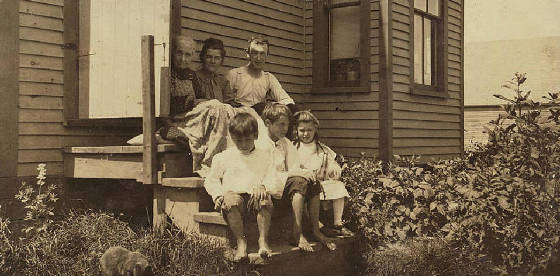
Lewis Hine caption: Hamilton Family, sardine works, Eastport. Father earns $15 to $25 a week irregularly during the work season for three months. Said that 20 years ago he made $5 a day as a boy, cutting. The mother is a packer makes $10 a week and upward, during the active season. Another boy, not in the photo, works also. In the front row are George Hamilton, 11 years old, who cuts regularly–made a dollar in three hours the day before; Byron, with a badly cut finger, earns 25 cents a day; little Erna 8 years old works at cartoning. The father is dissatisfied with the irregular income, but cannot see the connection between his early boyhood work and his present stagnation. He is putting his little ones through the same process. Location: Eastport, Maine, August 1911.
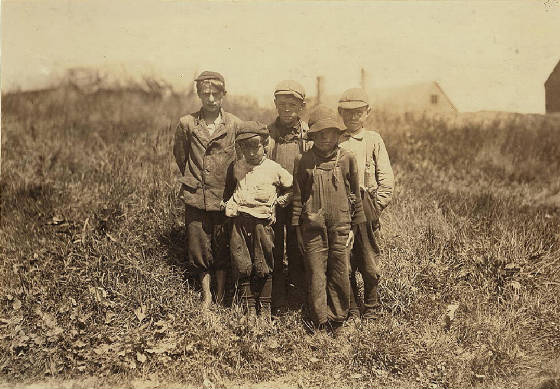
Lewis Hine caption: All these boys are cutters in the Seacoast Canning Co., Factory #7. Ages range from 7 to 12. They live near the factory. Seven year old boy in front, Byron Hamilton, has a badly cut finger, but helps his brother regularly. Behind him is his brother, George, 11 years. He cut his finger half off while working. They and many other youngsters said they were always cutting their fingers. George earns $1.00 some days, $.75 usually. Some of the others said they earn $1.00 when they work all day. At times they start at 7 a.m., work all day and until midnight, but the work is very irregular. Names of those in photo are George Mathews, Johnny Rust, John Surles[?], Fulsom McCutchin (11 yrs.), Albert Robinson, Morris McConnell. Location: Eastport, Maine, August 1911.
According to Byron’s cousin, Elaine Lodge: “The family used to go down to Massachusetts and work in the hat factories in Medfield in the winter. A lot of people here used to work in the cannery here in the summer, and go to the hat factories in the winter. My mother was a school teacher. She told me the kids would go to school in the winter and work in the cannery from April to October or November. That was when there were no child labor laws. When I went to work, I had to get a permit. I was 14, but I couldn’t work near any of the machinery. I had to be 18 to do that. I packed the fish in the cans, and then worked with the machinery when I was 18.”
In the 1930 census, William, Susan and Byron were renting a home in Medfield, Massachusetts. Military records show that Byron enlisted as a warrant officer in the US Army on July 23, 1942. He was single, with one year of college, and his civilian occupation was water pumpman. He later married Thelma and they had no children. Thelma passed away in Medfield in 1991, on her 89th birthday. Byron passed away in Medfield on December 22, 1995, at the age of 91. Both are buried at Vine Lake Cemetery in Medfield, along with many members of his family.
I spent a lot of time searching for descendants. The problem was that I could not obtain an obituary for Byron. After contacting several libraries in and around Medfield, and even the Boston Public Library, no newspaper obituary turned up. I even considered making the two-hour drive to Medfield and asking some senior citizen agencies if anyone remembered him. Finally I contacted the Medfield Historical Society and they found the obit. Among the descendants named was George Hamilton, a nephew, who lives less than an hour from me in Western Massachusetts. I had a delightful visit with him and his wife. George is the son of Byron’s brother George, who appears in several of the Hine photos. Mr. Hamilton was pleasantly surprised to see the photos. He connected me to Byron’s cousin in Eastport, 94-year-old Elaine Lodge, whom I also interviewed.
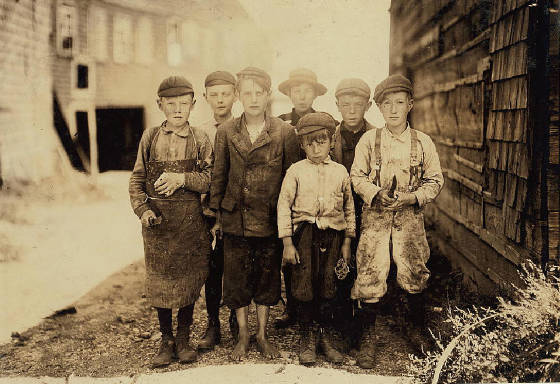
Lewis Hine caption: All these boys are cutters in the Seacoast Canning Co., Factory #7. Ages range from 7 to 12. They live near the factory. Seven year old boy in front, Byron Hamilton, has a badly cut finger, but helps his brother regularly. Behind him is his brother, George, 11 years. He cut his finger half off while working. They and many other youngsters said they were always cutting their fingers. George earns $1.00 some days, $.75 usually. Some of the others said they earn $1.00 when they work all day. At times they start at 7 a.m., work all day and until midnight, but the work is very irregular. Names of those in photo are George Mathews, Johnny Rust, John Surles[?], Fulsom McCutchin (11 yrs.), Albert Robinson, Morris McConnell. Location: Eastport, Maine, August 1911.
Edited interview with George Hamilton, nephew of Byron Hamilton, and George’s wife, Cecilia Hamilton. Interview conducted by Joe Manning (JM) on October 24, 2008.
JM: I found your family in the census from 1880 through 1930. I brought copies with me to show you. In 1880, your great-grandparents were living in Eastport: James Hamilton, his wife Susan, and their children, Annie, Edward and William, who was your grandfather. Your great-grandparents are in the 1900 census, too. He’s 69 and she’s 66, and there are no children in the home. Also in 1900, in Eastport, I found your father, George. He’s less than a year old, and he’s living with his father, James, his mother, Susan, and his brother Raymond. It’s interesting that both your great-grandmother and your grandmother were named Susan.
George: My grandmother Susan’s maiden name was Farris.
JM: Yes, here she is in the 1880 census. She was 13 years old, living in Eastport with her father, William and mother, Lucretia, and some brothers and sisters.
George: That sounds right.
JM: In the 1910 census, in Eastport, there’s William J. Hamilton, wife Susan, Raymond, George, Irena and Byron. Also living with them is Susan Hamilton, your great-grandmother. She’s 75.
George: Irena? Her name was Irma. And William’s middle name was James.
JM: In the 1920 census, they are still in Eastport. Byron is the only child in the home. In the 1930 census, here’s your father, George, living in Medfield, Massachusetts. He’s 30 years old. Also listed is your mother, Catherine, daughter Phyllis, and Catherine’s parents. I also found William James Hamilton living with wife Susan, and son Byron, in Medfield.
Cecilia: William was born in 1866 and died in 1946. His father, James, was born in New Brunswick.
JM: When were you born, George?
George: 1932, in Framingham, Massachusetts.
JM: How long did you know your Uncle Byron?
George: I knew him when I was a child, so I guess I must have known him for over 50 years.
JM: Where was Byron living when you were growing up?
George: He was living in Medfield.
JM: What did he do for a living?
George: He was a stationary fireman or engineer (operates and maintains boilers and other heating equipment). Then he was in the service. I think he was in White Sands, New Mexico, where they tested atomic energy. I think he also went to Hawaii. I don’t know what he did in his later years.
JM: Did you have a close relationship with him?
George: I saw him quite a bit.
JM: When did your parents leave Maine and come to Massachusetts?
George: I haven’t the slightest idea.
JM: Why did your family move to Massachusetts?
George: There wasn’t any work in Eastport, so they started migrating south. They worked in the mills around Lowell and Haverhill. And then they moved to places like Medfield and Norwood, wherever they could find work. My father, George, was also a stationary fireman. Uncle Ray was in Norwood, but I don’t remember what he did. Irma was a homemaker.
JM: Did Byron go to college?
George: No, but he was extremely brilliant. If he had had money, he certainly would have gone to college. He liked to quote poetry and the classics.
JM: Did he tell you he worked at the sardine cannery when he was a child?
George: No, but I knew my family was doing that in Eastport.
JM: Did they ever talk about it?
George: Not much.
JM: What was Byron like?
George: He was very outgoing and had a number of friends.
JM: How tall was he?
George: Maybe 5′ 8″.
JM: It looks like he married Thelma kind of late in life.
George: Yes, he did. They didn’t have any children. She had been married before.
JM: I found out that Byron and Thelma lived at a retirement home in Norfolk in their last years. I called the home and talked to the social worker. She had been working there about 20 years. I asked her if she remembered them, and she said she did. I asked her what she remembered about Byron, and she said, ‘Not much. He sort of kept to himself. But I do remember that he loved to read poetry.’
Cecilia: He lived on the second floor of the retirement home, and after his wife died, he used to clean the staircases and the halls. It gave him something to do. He used to go to his sister’s house and work like a dog doing everything and anything. Whatever it was, he could handle it. One time, he came up here and raked leaves for maybe half the morning. He was always busy, busy, busy.
JM: The Hine photo shows that he cut his finger badly. Did you ever notice any evidence of an injured finger?
George: No, and he never mentioned it.
JM: When did your father die?
Cecilia: My husband’s father died around 1954, in Medfield.
JM: When did your mother die?
Cecilia: My husband’s mother died August 7, 1990, in Norwood. She was 90.
JM: How did you wind up living in Lenox (Massachusetts)?
George: When I graduated from Boston University, I didn’t have a job. I had some background in nature and environmentalism. So I looked for a job that had something to do with that. I looked up the Audubon Society office in Boston, and they had a job opening at the Pleasant Valley Sanctuary in Lenox. So that’s how we arrived here.
JM: Your father worked in factory jobs, and you wound up going to a very highly rated university. How did that happen?
George: I came from a poor family. You can tell by the pictures. Fortunately, I went into the service. That was in 1951. Through that, I managed to get the GI Bill, which helped quite a bit with the tuition. And I worked part time as a tree climber.
JM: What motivated you to go to Boston University?
George: My sister suggested Boston University. They were very amenable to giving preference to soldiers who had the GI Bill. I majored in liberal arts.
JM: Were you the first person in your family to go to college?
George: No, my sister went first, to Framingham State.
JM: Hine’s purpose was to expose child labor in order to get laws to prohibit it. Do you think your family was a good example of bad child labor conditions?
George: Well, it was a typical occupation for people in that area then. The pay was mediocre. It’s still like Appalachia up there. We go up there every year, and we frequent the church on the Indian reservation. I asked one of the Indians why there were so many of them that had a military background. He said that’s because there wasn’t much work there, so one of the things they could do was join the service.
JM: Hine took a lot of pictures of kids who cut fish with big knives. They seemed to be awfully young to be doing that.
George: The knives weren’t that big.
JM: But they were sharp.
George: They did use sharp knives back then. Have you heard the term, ‘herring choker?’ They grab the fish, they cut off the head, they cut off the tail, and put it in a can that’s sealed with lead. That’s how they got the name ‘herring chokers.’ People from Nova Scotia and New Brunswick did that kind of work. You hear people say, ‘He was a Nova Scotian, herring choking so and so.’
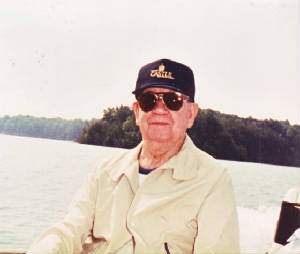
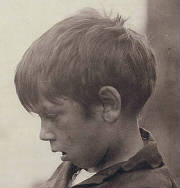
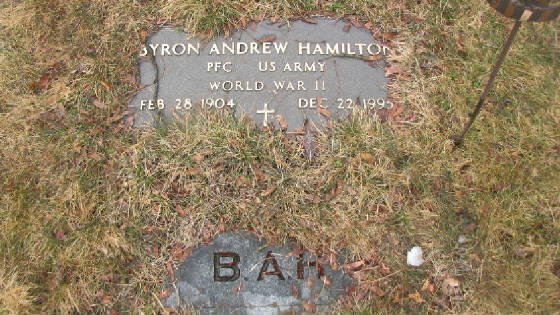
*Story published in 2010.